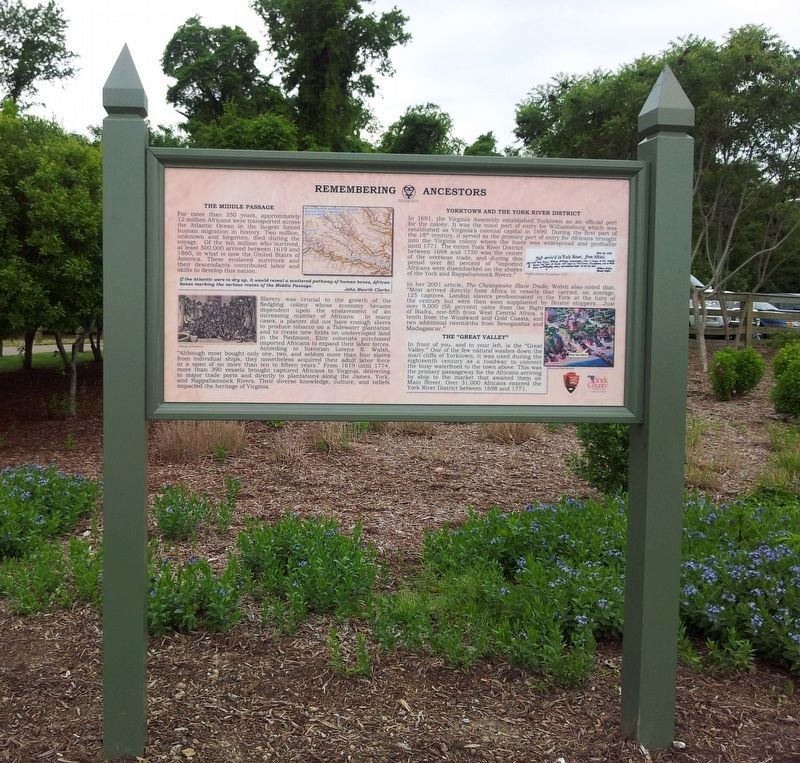Yorktown in York County, Virginia — The American South (Mid-Atlantic)
Remembering Ancestors
Inscription.
The Middle Passage
For more than 350 years, approximately 12 million Africans were transported across the Atlantic Ocean in the largest forced human migration in history. Two million, unknown and forgotten, died during the voyage. Of the ten million who survived, at least 500,000 arrived between 1619 and 1860, in what is now the United States of America. These enslaved survivors and their descendants contributed labor and skills to develop this nation.
Slavery was crucial to the growth of the fledgling colony whose economy became dependent upon the enslavement of an increasing number of Africans. In many cases, a planter did not have enough slaves to produce tobacco on a Tidewater plantation and to create new fields on undeveloped land in the Piedmont. Elite colonists purchased imported Africans to expand their labor forces. According to historian Lorena S. Walsh, “Although most bought only one, two, and seldom more than four slaves from individual ships, they nonetheless acquired their adult labor force in a span of no more than ten to fifteen years.” From 1619 until 1774, more than 390 vessels brought captured Africans to Virginia, delivering to major trade ports and directly to plantations along the James, York, and Rappahannock Rivers. Their diverse knowledge, culture, and beliefs impacted the heritage of Virginia.
Yorktown and the York River District
In 1691, the Virginia Assembly established Yorktown as an official port for the colony. It was the main port of entry for Williamsburg which was established as Virginia’s colonial capital in 1699. During the first part of the 18th century, it served as the primary port of entry for Africans brought into the Virginia colony where the trade was widespread and profitable until 1771. The entire York River District between 1698 and 1750 was the center of the overseas trade, and during this period over 80 percent of “imported Africans were disembarked on the shores of the York and Rappahannock Rivers.”
In her 2001 article, The Chesapeake Slave Trade, Walsh also noted that, “Most arrived directly from Africa in vessels that carried, on average, 125 captives. London slavers predominated in the York at the turn of the century but were then soon supplanted by Bristol shippers….Just over 9,000 (56 percent) came from the Bight of Biafra, one-fifth from West Central Africa, a tenth from the Windward and Gold Coasts, and two additional twentieths from Senegambia and Madagascar.”
(sidebar)
The "Great Valley"
In front of you, and to your left, is the “Great Valley.” One of the few natural washes down the marl cliffs of Yorktown, it was used during the eighteenth century as a roadway to connect the busy waterfront to the town above. This was the primary passageway for the Africans arriving by ship to the market that awaited them on Main Street. Over 31,000 Africans entered the York River District between 1698 and 1771.
Erected 2013 by Middle Passage Ceremonies and Port Markers Project. (Marker Number 1.)
Topics. This historical marker is listed in this topic list: African Americans. A significant historical year for this entry is 1698.
Location. 37° 14.075′ N, 76° 30.283′ W. Marker is in Yorktown, Virginia, in York County. Marker can be reached from Water Street near Comte de Grasse Streets. Touch for map. Marker is in this post office area: Yorktown VA 23690, United States of America. Touch for directions.
Other nearby markers. At least 8 other markers are within walking distance of this marker. Yorke Village (a few steps from this marker); Yorktown's Sunken Fleet (within shouting distance of this marker); The Brig Betsy (within shouting distance of this marker); York “Under The Hill” (within shouting distance of this marker); York Under Siege 1781 (about 300 feet away, measured in a direct line); An Archer House (about 300 feet away); Pirates in Yorktown? (about 400 feet away); Chesapeake Bay Impact Crater (about 400 feet away). Touch for a list and map of all markers in Yorktown.
Regarding Remembering Ancestors. Built at the mouth of the York River and the Chesapeake Bay, the Yorktown settlement functioned as the entry point for most ships coming to the Virginia colony. Tariffs and commercial transactions related to tobacco and imports were handled by factors and magistrates at this site. Voyages database identified the York River as the arrival location of 24,407 captive African people who were delivered by 145 ships to the English settlements and to plantations on the river between 1698 and 1773. Because Williamsburg, which became the capital of Virginia in 1699 was land locked, Yorktown was the colony’s principal international port city until 1779.
Also see . . . Middle Passage Ceremonies and Port Markers Project. (Submitted on March 1, 2020, by John Bloomfield of Palm Coast, Florida.)
Credits. This page was last revised on March 1, 2020. It was originally submitted on March 1, 2020, by John Bloomfield of Palm Coast, Florida. This page has been viewed 275 times since then and 33 times this year. Photos: 1, 2. submitted on March 1, 2020, by John Bloomfield of Palm Coast, Florida. • Bernard Fisher was the editor who published this page.
Editor’s want-list for this marker. Accurate GPS coordinates. • Can you help?

